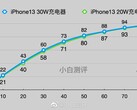Apple’s new iPhone 13 series and iPad mini 6 models are finally rolling out across the globe. We’ve managed to get our hands on both the iPhone 13 Pro Max and the iPad mini 6 in the new and stunning Sierra Blue and Starlight colors, respectively. Our early Geekbench testing confirms recent leaks showing the A15 Bionic to be a blazingly fast mobile SoC, by far the fastest on the market.
While the regular iPhone 13 features a new A15 Bionic like the iPhone 13 Pro models and the iPad mini 6, its GPU utilizes a 4-core design. The iPhone 13 Pro and iPad mini 6 get a variant that has an extra GPU core for a total of 5 cores, although the iPhone 13 Pro gets 6 GB RAM while the iPad mini is limited to 4 GB. As we learned a few days ago, the A15 Bionic in the iPad mini is clocked lower with a peak clock speed of 2.94 GHz versus 3.23 GHz in the iPhone 13 Pro. This results in a lower single core score of 1592 against the 1734 single core of the A15 in the iPhone Pro -- a similar result is seen in the multicore score too (4508 against 4793).
What we didn’t know until now, however, is that even though the A15 Bionic in both devices has the 5-core configuration, the iPad mini also records a slightly slower result in the Geekbench Metal test. Here, it scores 13857 against a score of 14419 delivered by the iPhone 13 Pro. Clearly, it is still an incredibly powerful chip, but it does suggest that Apple looks to be increasingly using binned parts to maximize its yields. A15 Bionic chips with a non-functional 4th core (but high performing CPU) go to the regular iPhone 13, top tier performing chips are going to the iPhone 13 Pro and chips that don’t meet the iPhone 13 Pro performance spec with all cores functional go to the new iPad mini.
Buy the iPad mini 6 with Wi-Fi and 64 GB of RAM in Starlight for US$500 from Amazon.
Source(s)
Sanjiv Sathiah via Twitter





















